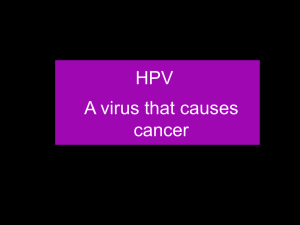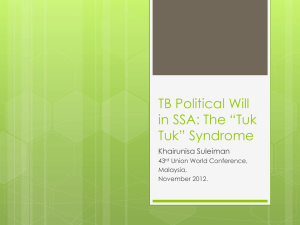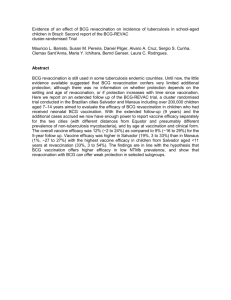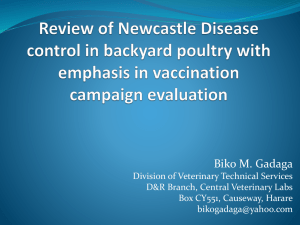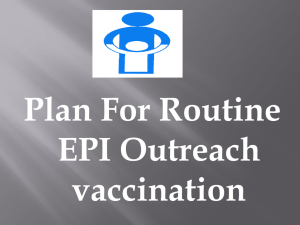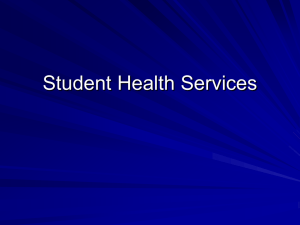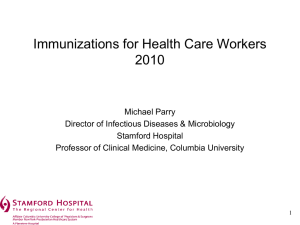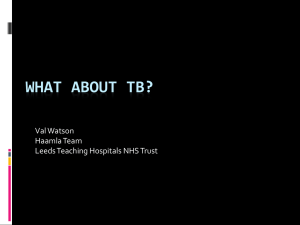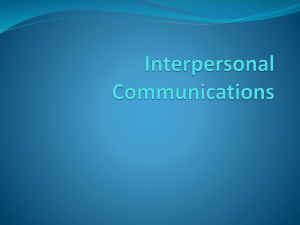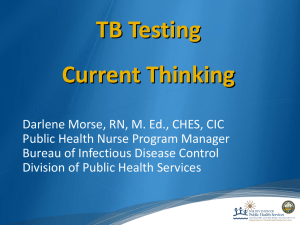Document
advertisement
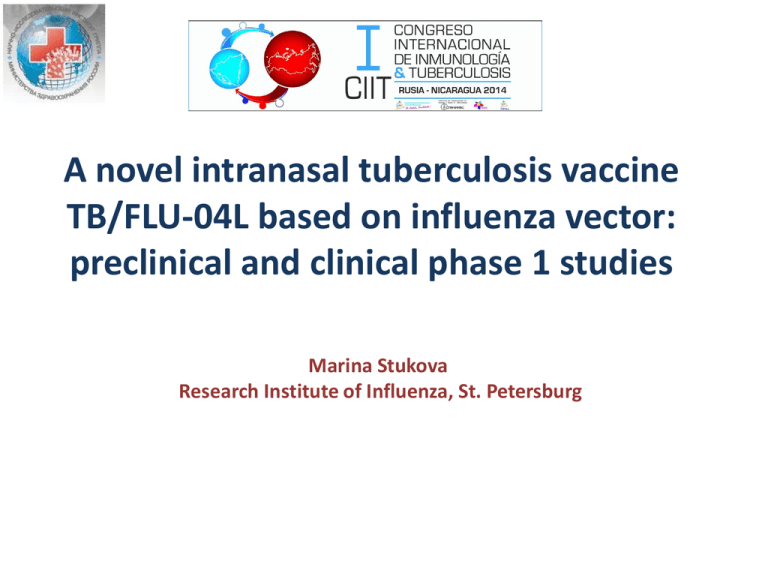
A novel intranasal tuberculosis vaccine TB/FLU-04L based on influenza vector: preclinical and clinical phase 1 studies Marina Stukova Research Institute of Influenza, St. Petersburg Recombinant viral vector vaccines have several advantages over protein based or inactivated vaccines o Availability of attenuated strains o Lack of chromosomal integration o Antigenic variability and possibility of repeated vaccinations Deletion of the effector domain of NS1 protein leads to attenuation of the virus (Hale et al., 2005). o Viral vectors are able to induce a full spectrum of humoral and cellular immune responses initiated at mucosal surfaces. o Viral vectors have self-adjuvanting activities through the stimulation of innate immune systems. Recombinant influenza vector expressing two mycobacterium antigens: Esat-6 and Ag85A Recombinant NS gene structure Genetic stability Expression of Mtb antigens in Vero cells ESAT-6 Ag85A TEM of a recombinant influenza A virus particles Flu/TB safety, immunogenicity and protective efficacy in mice Virus shedding FLU/TB Antigen specific immune response to Flu/TB vaccination (ELISPOT) Bacterial growth in the lungs and spleen of vaccinated and control mice 5 and 20 weeks after i/v challenge with virulent M. Erdman Lungs 5 weeks after challenge with virulent M.Erdman Log10 Spleen CFUs protection BCG 5,23±0,07 FLU/TB 5,28±0,04 Groups Unvaccinated 5,91±0,02 control Log10 Lungs 20 weeks after challenge with virulent M.Erdman Log10 Spleen CFUs protection CFUs protection CFUs protection 0,68* 3,64±0,08 0,67 4,92±0,07 1,24 3,94±0,11 1,33* 0,63* 3,74±0,09 0,45 4,73±0,03 1,43 3,93±0,12 1,34* - 4,19±0,06 - 6,16±0,12 - 5,27±0,04 - Log10 Flu/TB enhances protective effect of BCG vaccination Bacterial growth in the lungs and spleen 4 weeks after i.v. challenge with M. Erdman Development of lung pathology in mice 4 weeks after i.v. challenge with M. Erdman BCG + FLU/TB C Lungs CFUs Lung protection Versus Control BCG 0,9* BCG 4,7±0,03 BCG + FLU/TB 3,75±0,05 1,85* Unvaccinated control 5,6±0,06 - Control 0,95** Spleen CFUs Spleen protection Versus Control BCG 3,6±0,06 0,7* 3,1±0,07 1,2* 0,5** 4,3±0,2 Survival Rate E x 300 A BCG Groups D F * ** 50 x 600 B P e r c e n t s u r v iv a l 100 0 0 50 100 150 200 Days C o n tro l BCG B C G + T+B /F L U -0 4 L FLU/TB Flu/TB safety and immunogenicity in cynomolgus monkeys Antigen specific IFN-γ response to Flu/TB vaccination (lymphocyte stimulation) Temperature (A) and body weight (B) dynamics of adult Macaca fascicularis i.n. immunized with FLU/ТВ vector B. 40 The data were considered statistically significant when p<0,05 (*). 6 39.5 39 Body weight (kg) Body temperature (ºС) A. 38.5 38 37.5 37 5 Following vaccination: 4 3 36.5 36 2 0 2 4 8 Days 21 42 0 2 4 8 Days 21 42 No virus shedding No weight loss No temperature elevation Stabile parameters of CBC and blood chemistry TB/FLU-04L safety in ferrets and guinea pigs Test system Number of animals/group Dose, method of administration Noteworthy findings Ferrets TB/FLU-04L N=6 Control (SPGN) N=5 0,5 ml (7,5 lg/dose), i/n - No clinical symptoms, no inappetence, no febrile reactions; Single immunization - No virus recovery from nasal washings; - No decrease in the body weight; - No neurological manifestations. Guinea pigs TB/FLU-04L N=10 Control (SPGN) N=10 0,5 ml (7,5 lg/dose), i/n -No clinical symptoms, no inappetence, no febrile reactions; Single immunization -No negative effect on hematology parameters (complete blood count and blood chemistry); - No decrease in the body weight. TB/FLU-04L toxicology studies in mice, guinea pigs and rats Type of study Test system Number of animals/group Dose, method of administration Noteworthy findings Acute toxicity Mice Guinea pigs N=10 N=10 0,5 ml, i/p 5,0 ml i/p Did not cause death; change of appearance or in motility, behavioral reactions or food or water consumption. Body weight ∆ in experimental group=control group Repeat-dose toxicity Mice N=20 0,5 ml/animal, i/n 0,025 ml/nostril x10 Guinea pigs N=20 No changes of appearance or in motility, behavioral reactions or food or water consumption. Body weight ∆ in experimental group=control group. Histology: no inflammatory, dystrophic or destruction changes in internal organs and brain. Histological pattern of the organs from vaccinated animals didn’t differ from the relevant control samples. 5 ml/animal, i/n 0,25 ml/nostril x10 General anaphylaxis reaction N=10 Guinea pigs 0,1ml (7,5 lg)/dose, i/n double immunization N=10 No anaphylactic shock signs 0,1ml (8,5 lg)/dose, i/n double immunization Immune complex reactions Guinea pigs N=10 0,1ml (7,5 lg)/dose, i/d single administration No skin reactions observed Conjunctiva test Guinea pigs N=10 0,1ml (7,5 lg)/dose, i/o double immunization No visible changes Effect on weight and total cell count of lymph organs Mice N=10 0,1ml (7,5 lg)/dose, i/n double immunization No reduction in weight of the lymphoid organs mass and cell count of spleen, thymus, cortical bone and popliteal lymph nodes. No difference with the relevant control samples. Local irritation effects Rats N=10 0,1ml (7,5 lg)/dose, i/n double immunization No irritation, inflammation or destruction of tissue at the application site (examination and histological findings). Conclusions TB/FLU-04L vaccine is safe (mice, ferrets, guinea pigs) and immunogenic (mice, monkeys). Protective efficacy of TB/FLU-04L is comparable with BCG (mice, guinea pigs). TB/FLU-04L has no toxic effects (mice, guinea pigs, rats) TB/FLU-04L represents an effective way to boost immune protection of BCG vaccination (mice). Randomized double-blind placebo-controlled phase 1 trial of intranasal TB/FLU-04L tuberculosis vaccine in BCG-vaccinated healthy adults aged 18 - 50 years 2013-2014 Study Design TB/FLU-04L o Phase I o Single Center o Randomized o Double-blind o Placebo Controlled (TB/FLU-04L: Placebo = 1:1) o Two Doses in 21 days interval o Healthy Volunteers o 36 healthy male or female volunteers – 18-50 years of age – Previously vaccinated with BCG – No evidence of infection with Mycobacterium tuberculosis (QFT - negative) o Primary objective: Safety, tolerability, PK (shedding) o Secondary objectives: Local and systemic immune response o Duration/volunteer: 6w Study Flow Chart * Safety Monitoring Committee review on or soon after Days 8 and 28 for each cohort. Investigational Medicinal Product (Vero derived) TB/FLU-04L [replication-deficient recombinant influenza virus A expressing ESAT-6 and Ag85A antigens] Study Population Nasal spray 500µl (250µl/nostril) Safety Overall summary of subjects with adverse events in the 7 days post-Doses 1 and 2 7 days after the first vaccination Worst grade Vaccine (N=18) n (%**) 95% CI Placebo (N=18) n (%**) 95% CI Any solicited local or systemic 7 (38.9) 17.3-64.3 6 (33.3) 13.3reaction* 59.0 Local reactions* 5 (27.7) 9.7-53.5 5 (27.7) 9.7-53.5 Nasal congestion mild 4 (22.2) 6.4-47.6 2 (11.1) 1.4-34.7 Pharynx hyperemia mild 1 (5.6) 0.1-27.3 4 (22.2) 6.4-47.6 Nose dryness mild 2 (11.1) 1.4-34.7 0 (0.0) 0.0-18.5 Sneeze mild 0 (0.0) 0.0-18.5 1 (5.6) 0.1-27.3 Systemic reactions* 4 (22.2) 6.4-47.6 4 (22.2) 6.4-47.6 Sore throat mild 4 (22.2) 6.4-47.6 3 (16.7) 3.6-41.4 Fever mild 1 (5.6) 0.1-27.3 0 (0.0) 0.0-18.5 Headache mild 2 (11.1) 1.4-34.7 1 (5.6) 0.1-27.3 Fatigue mild 2 (11.1) 1.4-34.7 0 (0.0) 0.0-18.5 Cough mild 0 (0.0) 0.0-18.5 1 (5.6) 0.1-27.3 Worst grade – mild 16 12 Worst grade – moderate or severe 0 0 Any serious adverse event 0 0 * A subject with more than one finding in specific category was only counted once **Percentages based on total no. of subjects in each treatment group 7 days after the second vaccination During 7 days following Dose 1, local and systemic expected adverse events occurred at a similar rate between study vaccine recipients and were mild, transient and self-limiting. No SAE, no Immediate Reactions to vaccination occurred. Vaccine (N=16) Worst grade Placebo (N=18) n (%**) 95% CI n (%**) Any solicited local or systemic 1 (6.3) 0.2-30.2 0 (0.0) reaction* Local reactions* 0 (0.0) 0.0-20.6 0 (0.0) Systemic reactions* 1 (6.3) 0.2-30.2 0 (0.0) Headache mild 1 (6.3) 0.2-30.2 0 (0.0) Worst grade – mild 1 0 Worst grade – moderate or severe 0 0 Any serious adverse event 0 0 * A subject with more than one finding in specific category was only counted once **Percentages based on total no. of subjects in each treatment group 95% CI 0.0-18.5 0.0-18.5 0.0-18.5 0.0-18.5 During 7 days following Dose 2, no any local AEs were observed in both vaccine and placebo groups, one systemic self-limiting adverse event of mild severity (headache) was reported in the vaccine group. Viral Shedding Nasal swab samples taken on Day 2 (24h), Day 3 (48h) and Day 5 after vaccination Day 1 (before 1st vacc.) Day 2 Day 3 Day 5 negative Vaccine (N=18) n (%) 18 (100.0) Placebo (N=18) n (%) 18 (100.0) positive 0 (0.0) 0 (0.0) negative 13 (86.1) 18 (100.0) positive 5 (13.9) 0 (0.0) negative 18 (100.0) 18 (100.0) positive 0 (0.0) 0 (0.0) negative 18 (100.0) 18 (100.0) positive 0 (0.0) 0 (0.0) Presence of influenza virus A specific RNA Day No virus detected at or beyond the third day of follow-up Evaluation of virus shedding according to rRT-PCR data showed that influenza virus RNA was identified in nasal swab specimens collected from vaccinated subjects 24 hours post-vaccination thus providing evidence for replication-deficient phenotype and confirming attenuation of the vaccine strain. Overall Safety Conclusion The vaccine was well tolerated and no clinically significant safety signals were detected during the daily clinical evaluations and pre- or post-vaccination metabolic and hematologic laboratory panels performed. Vaccine virus in nasal swabs was detected only on the second day after the first vaccination in 5 of 18 volunteers. In no case shedding of vaccine virus was detected at or beyond the third day of follow-up. TB/FLU-04L is safe and well tolerated Immunological Parameters o Frequency of Ag-specific CD4 and CD8 T-cell responses and memory phenotype of cytokine-producing cells by intracellular cytokine staining (ICS) in whole blood o Local cytokine production in nasal secretion samples by multiplex system FlowCytomicx Th1/Th2/Th9/Th17/Th22 o Vector-specific hemagglutinin antibodies (HAI assay, ELISA) utilizing serum samples o T cell proliferation and extracellular cytokine production using dilution of carboxyfluorescein diacetate succinimidyl esters (CFSE) by flow cytometry in PBMCs – ongoing o Antigen-specific serum antibodies (ELISA) in serum samples Nasal cytokines production Nasal secretions were collected before, 24 and 48 hours post-vaccination TB/FLU-04L Placebo P values were calculated using the Wilcoxon matched-pairs signed rank test Despite the considerable individual variation in cytokine levels there were significant differences in IL-1β (24h P=0.0253), TNF-α (24h P=0.0130) and IL-2 (24h P=0.0153; 48h P=0.0431) production between the TB/FLU-04L and placebo groups. Ag85A/ESAT-6-specific IFN-γ secreting CD8+ and CD4+ memory T cells Ag85A ESAT-6 TB/FLU04L TB/FLU04L Placebo A A B B 0 .8 1 .0 T c e lls (% ) 1 .2 P = 0 ,0 1 1 2 0 .6 0 .6 0 .2 0 .2 + 0 .2 + 0 .0 0 0 .0 1 .2 1 .0 0 .0 0 .6 P = 0 ,0 0 9 0 0 .4 0 .2 21 42 0 .8 0 .6 0 .4 - 0 .4 0 .2 + + 0 .2 P = 0 ,0 0 5 9 7 0 .2 + 0 .6 + 0 .4 0 D - 0 .8 - - 0 .6 42 0 .8 IF N - C D 4 5 R A C D 4 + 0 .8 21 T c e lls ( % ) 1 .4 + 1 .0 7 42 C IF N - C D 4 5 R A C D 4 T c e lls ( % ) 1 .2 21 1 .6 P = 0 ,0 3 3 7 1 .4 7 + 0 IF N - C D 4 5 R A C D 4 42 T c e lls ( % ) 21 + 7 D 1 .6 T c e lls ( % ) 0 .4 0 .0 0 IF N - C D 4 5 R A C D 4 0 .6 - 0 .2 + 0 .4 + + 0 .4 0 .4 - 0 .8 - 0 .6 IF N - C D 4 5 R A C D 8 IF N - C D 4 5 R A C D 8 + IF N - C D 4 5 R A C D 8 0 .8 - IF N - C D 4 5 R A C D 8 + + 1 .0 T c e lls (% ) P = 0 ,0 1 0 7 1 .2 0 .0 C 0 .8 P = 0 ,0 4 2 0 1 .4 T c e lls ( % ) T c e lls ( % ) 1 .4 Placebo 0 .0 0 .0 0 .0 0 7 21 Time (days) 42 0 7 21 Time (days) 42 0 7 21 Time (days) 42 0 7 21 42 Time (days) Frequency of Ag85A/ESAT-6-specific IFN-γ secreting CD8+ (A, B) and CD4+ (C, D) memory T cells induced by TB/FLU-04L, as measured by flow cytometry after incubation of whole blood with Ag85A/ESAT-6 recombinant proteins. Each line displayed represents a vaccine participant. Background values (unstimulated) were subtracted for each condition from each individual. Indicated P values were calculated using the Wilcoxon matched-pairs signed rank test. Overall Immunogenicity Conclusion o Vaccination induced statistically significant CD4+ and CD8+ T-cell response against both Ag85A and ESAT-6 antigens. Overall, 50% of TB/FLU-04L vaccinated subjects responded to any antigen at any time point with significant increases in virus–specific T–cells. o Most of IFN-γ secreting antigen-specific CD8+ and CD4+ T-cells were characterized by the absence of CD45RA marker, indicating memory phenotype of the cells. There was strong correlation between CD8+ and CD4+ memory Tcell response for both antigens: Ag85A (Spearman ρ=0.933, P<0.0001), ESAT-6 (Spearman ρ=0.8657, P<0.0001). o CD8+ and CD4+ memory T-cell ESAT-6-specific response had different kinetics in comparison with Ag85A-specific response: • Ag85A-specific CD8+ and CD4+ memory T-cell response peaked at day 21 post-vaccination with the decrease nearly to the baseline on day 42. The absence of clear boosting effect after second vaccination could be due to re-distribution of memory T cells from peripheral blood to the peripheral tissues. • In most individuals CD8+ and CD4+ T-cell ESAT-6-specific response also peaked on day 21, but maintained or even increased for the 42 day. o Local nasal cytokines production was determined as early immune response to vaccination. Despite the considerable individual variation in cytokine levels there were significant differences in IL-1β (24h P=0.0253), TNF-α (24h P=0.0130) and IL-2 (24h P=0.0153; 48h P=0.0431) production between the TB/FLU-04L and placebo groups. o No increase in antibody levels against influenza vector was shown in vaccine recipients. Thank you for your attention! Stukova M., Khairullin B.2, Bekembaeva G.2, Shurygina A-P.1, Erofeeva M.1, Pisareva M.1, Buzitskaya J.1, Grudinin M.1, Kassenov M.2, Nurpeisova A.2, Sarsenbaeva G.2, Zabolotnyh N.3, Vinogradova T.3, Egorov A.1, Sansyzbay A.2, Kiselev O.1 Research institute of influenza, St. Petersburg, Russia1; Research Institute for Biological Safety Problems, Gvardeyskyi, Kazakhstan2, Saint-Petersburg Research Institute of Phthisiopulmonology, St. Petersburg, Russia3
